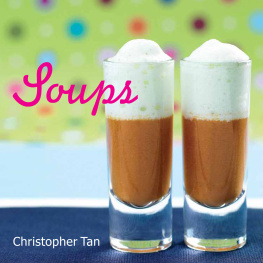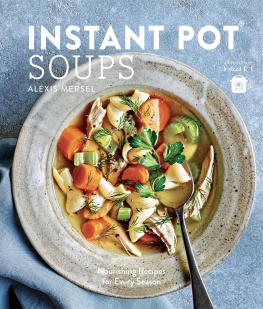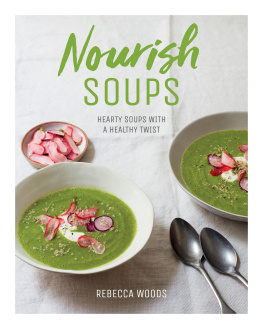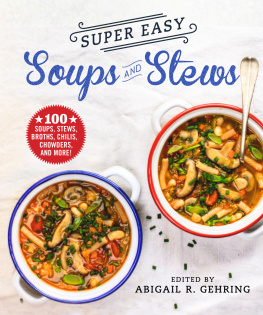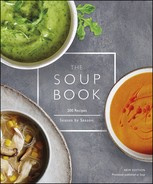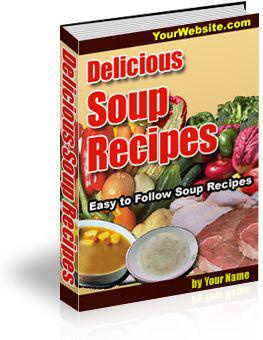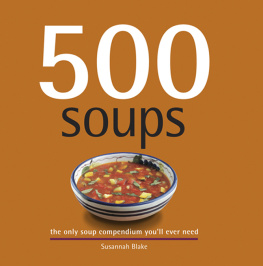delicious SOUPS


delicious SOUPS
fresh & hearty soups for every occasion
BELINDA WILLIAMS
photography by Steve Painter


Design, photography and prop styling
Steve Painter
Editor Rebecca Woods
Production Gary Hayes
Art Director Leslie Harrington
Editorial Director Julia Charles
Food stylist Lucy McKelvie
Food stylists assistant Ellie Jarvis
Indexer Hilary Bird
First published in 2013.
This edition published in 2020 by
Ryland Peters & Small
2021 Jockeys Fields
London WC1R 4BW
and
341 E 116th Street
New York, 10029
www.rylandpeters.com
10 9 8 7 6 5 4 3 2 1
Text Belinda Williams 2013, 2020
Design and photographs Ryland Peters & Small 2013, 2020
Printed in China
The authors moral rights have been asserted. All rights reserved. No part of this publication may be reproduced, stored in a retrieval system or transmitted in any form or by any means, electronic, mechanical, photocopying or otherwise, without the prior permission of the publisher.
eISBN: 978-1-78879-260-8
ISBN: 978-1-78879-196-0
A CIP record for this book is available from the British Library.
US Library of Congress CIP data has been applied for.
Notes
Both British (Metric) and American (Imperial plus US cups) measurements are included in these recipes for your convenience, however it is important to work with one set of measurements only and not alternate between the two within a recipe.
All spoon measurements are level unless otherwise specified.
All vegetables are medium-sized unless otherwise specified.
All eggs are medium (UK) or large (US), unless otherwise specified. Uncooked or partially cooked eggs should not be served to the very old, frail, young children, pregnant women or those with compromised immune systems.
When a recipe calls for the grated zest of citrus fruit, buy unwaxed fruit and wash well before using. If you can only find treated fruit, scrub well in warm soapy water before using.
Ovens should be preheated to the specified temperatures. We recommend using an oven thermometer. If using a fan-assisted oven, adjust temperatures according to the manufacturers instructions.
contents


Love, health and humour: the three most important things in life and the three most defining elements in this book. Everyone knows that home-cooked food is good for you good for the soul, good for the heart and good, in most cases, for the waistline! Soup is the food of endless versatility, comfort and joy.
It is because of the simplicity of soup, and its relevance to just about any culture or occasion, that we decided to start our company producing homemade soup on a commercial scale and thus Yorkshire Provender was born. I am proud of my heritage and wanted to bring the farmers and food producers to the fore, and to create a tangible link between producer and consumer, so often void on our supermarket shelves. A hand-crafted product produced by real people with real stories who care passionately about what they do. We remain one of the few soup producers who use fresh vegetables from sources we know. Our relationships with our growers and farming roots are still at the core of our ethos and guide us in all we do.
Happily, just about anyone can make soup, regardless of culinary ability. Simply start with quality ingredients, treat them well and the result will be delicious! I am very visually led and often seek inspiration from a single vegetable: a perfect cabbage, tender baby spinach or a gnarly celeriac/celery root they all lure me in and beg me to turn them into something wonderful.
I hope that I can encourage you, through the recipes in this book, to explore the endless possibilities of this wonderful medium. I have included all manner of options, from rustic fish stews to elegant velouts with scallops, so there is truly something for every occasion. Whether it be a picnic on the beach (try the Fresh Spinach Soup with Minted Pea and Coriander on , with a smoked trout and wasabi salad), a soup can be applied to all occasions, and it will do its job brilliantly. Like the perfect cashmere sweater, soup can be dressed up or dressed down and, regardless of the company, is always effortlessly appropriate.
I would also hope that you make each soup your own. If you are missing an ingredient or want to substitute one vegetable for another, then do it will be different, but it will not be a failure! I am the daughter of wartime babies and my parents were, and still are, from a generation who believed in throwing nothing away! I have that hangover from my childhood, where leftovers were half the fun of meal times. My mother would make bubble and squeak with leftover cabbage and mash, and meatballs with leftover Sunday joint passed through a huge hand-turned mincer/grinder clamped to the kitchen table. I still get an excited, satisfying pleasure in creating meals out of whatever I find left in the fridge, and much like my mothers, mine is always crammed full. Soups cry out for leftovers to be used, and most soups can be adapted to suit what you have left.
It is my memories of great experiences, moments, people and places that have inspired the recipes in this book. I hope you enjoy making these soups, and have the confidence to create some new ones of your own.
In this book I have referred to stock. I would never insist you make your own as there are some good powdered or compound stocks available (although try and use one with as few artificial additives as possible or your delicious soup could end up tasting like a poor packeted relation!). But I would actively encourage you to take the time to make your own. You can make these when you have a little time available or appropriate ingredients to hand and pop them in the freezer.
vegetable stock
2 onions, halved
2 leek, thickly sliced
1 fennel bulb, halved
4 celery sticks, thickly sliced
4 carrots, peeled and thickly sliced
12 bay leaves
a few sprigs of fresh thyme
a small bunch of fresh parsley
10 white peppercorns
sea salt
makes about 1.5 litres/6 cups
Put all ingredients in a large saucepan and top up with 2.5 litres/quarts water. Cover the pan with a lid, bring the liquid to a simmer. Let it simmer for 1 hours, removing the lid for the last 30 minutes so it can reduce a little. Pass the stock through a sieve/strainer and discard the solids. Adjust the seasoning with salt and use as per the recipe.
Tip: If you prefer a slightly richer flavour, brown the vegetables in a tablespoon butter before adding the liquid to the pan.
fish stock



